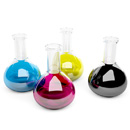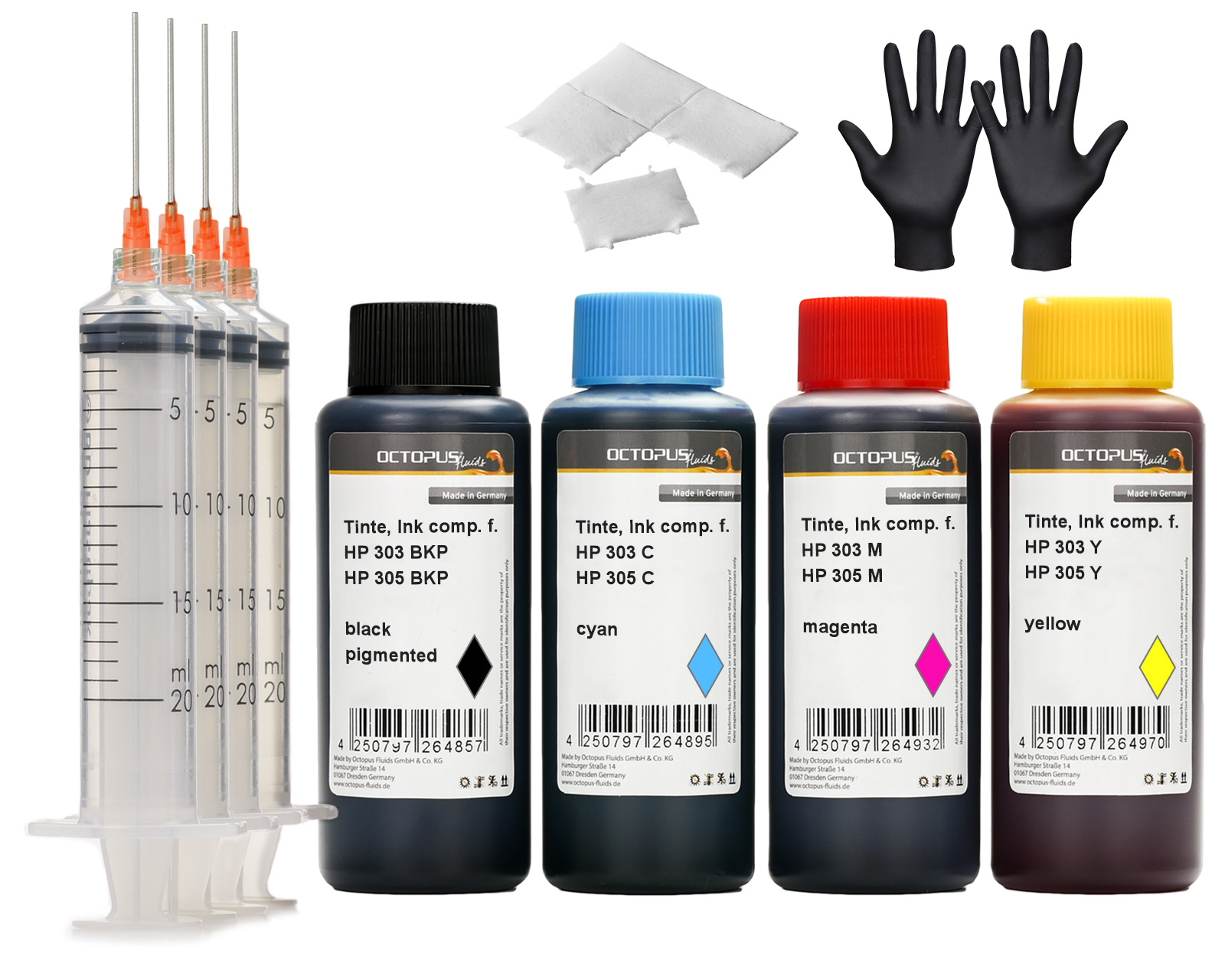What ink is used in printers?

The two basic types are water-based inks and pigmented inks. Water-based inks are pure solutions, while pigments in pigmented inks float around as fine particles, like in a slurry.
Both types are of course available not only in the basic colors black, cyan, magenta and yellow, but also in a wide variety of shades. For example, instead of Magenta, "Light Magenta pigmented" or "Photo Magenta" are also used. For Black inks, for example, there is "Photo Black", "Matte Black pigmented" or "Light Light Black pigmented". The situation is similar for Cyan and Yellow.
 Octopus printer ink set compatible for Epson 604 ink cartridges, WorkForce 2950DWF 2930DWF
Octopus printer ink set compatible for Epson 604 ink cartridges, WorkForce 2950DWF 2930DWF
 Printer Ink Set for Canon GI 46, GI 56 ink tank
Printer Ink Set for Canon GI 46, GI 56 ink tank
 Refill ink set compatible for HP 303 and HP 305 Ink Cartridges, DeskJet, DeskJet Plus, Envy, Envy Pro
Refill ink set compatible for HP 303 and HP 305 Ink Cartridges, DeskJet, DeskJet Plus, Envy, Envy Pro
 Octopus printer ink set compatible for Canon PG-560, CL-561 ink cartridges, Canon Pixma TS 5300, 7400
Octopus printer ink set compatible for Canon PG-560, CL-561 ink cartridges, Canon Pixma TS 5300, 7400
Isn't cyan actually blue?
Cyan is the essential basis for three-color printing (cyan, magenta, yellow only) and four-color printing (black in addition). Any required color can be mixed from yellow ink, magenta ink, cyan ink and, of course, black ink.
Cyan comes from the Greek (from κυανός) and describes a deep, dark blue.
However, this description is not quite accurate today. Cyan is not a pure blue but rather a light mixture of green and blue.
In modern times, an entire color category has been named after this word - the cyan hues.
The term itself has not been around that long. For example, in the RAL color system, which was created in the middle of the 20th century, no such category has been named yet. Only the turquoise colors are listed, but they are classified in the category "green".
There are actually only three areas in which cyan is used: on the Internet (as so-called web cyan), in the fashion industry (as a gradation of the blue-green tones) and above all in the printing industry.
The color magenta
Magenta is the name given to the aniline dye fuchsin.
The color is produced by additive mixing of red and blue and thus belongs to the purple colors (purple - the royal color - is obtained from purple snails. To dye 1 kg of wool, 12,000 snails are needed).
The term originated from the "Battle of Magenta" (1859) with which the dye was associated.
Magenta is used more frequently than cyan, e.g. in advertising for Deutsche Telekom.
And finally Yellow
The color yellow in the printing industry is actually called "process yellow" (in the EU also "Euroyellow") and is defined as a hue that should reflect red and green light equally and absorb all blue. At least that is the theory. In the eyes of the beholder, however, the color is clearly greenish, yet very garish.
Process yellow is not used very often, only ambulances are provided with it for optical reasons, i.e. simply to attract attention.
 OCTOPUS ink absorber for refilling ink converter and fountain pen cartridge
OCTOPUS ink absorber for refilling ink converter and fountain pen cartridge
 Octopus sales display for presentation of 120 Alcohol Inks or 48 fountain pen inks
Octopus sales display for presentation of 120 Alcohol Inks or 48 fountain pen inks
 Fill In, QuickFill printer cartridges for Epson 405 with chip resetter and printer ink
Fill In, QuickFill printer cartridges for Epson 405 with chip resetter and printer ink
Printing methods
Four-color printing is now the common method for home use, correspondence, etc. Two-cartridge systems and four-cartridge systems are used. Two-cartridge systems have one cartridge with black ink and one with three ink chambers for yellow ink, cyan ink and magenta ink.
What other printing forms are available?
There are, of course, other types of printing, the so-called "multicolor prints". These are mainly used for art prints and the like. Here, in addition to the four colors already mentioned, "gamut" or "opaque white" can be used, for example, to obtain colors such as "deep blue" or "deep green", which would not be possible with four-color printing. Of course, there are then special features where "gold" or "silver" is used.
 Fountain Pen Ink Sheen, Dragon, Petrol, 30 ml
Fountain Pen Ink Sheen, Dragon, Petrol, 30 ml
 Barock 1910 writing ink, fountain pen ink in 30 ml jar
Barock 1910 writing ink, fountain pen ink in 30 ml jar
 Document Ink blue, document-proof ink, certified according to DIN ISO 12757-2, 30 ml
Document Ink blue, document-proof ink, certified according to DIN ISO 12757-2, 30 ml
 Write and Draw Ink 337 Green Tiger, waterproof drawing ink for fountain pens, 50ml
Write and Draw Ink 337 Green Tiger, waterproof drawing ink for fountain pens, 50ml
Octopus Write & Draw Ink, waterproof ink for fountain pen, nib and brush, vegan
The Octopus Write & Draw inks are unique, smudge-proof and waterproof writing and drawing inks in a wide range of colours. They were developed for daily use in fountain pens and are also popular with graphic artists, illustrators, calligraphers and artists for writing, sketching, drawing and colouring with calligraphy pens, glass pens or brushes.
Each of the 38 brilliant shades inspires with its intense colour power thanks to its high, balanced pigmentation. In addition to a deep black and various shades of grey, the extensive colour palette also includes a particularly opaque white, which can be used on dark backgrounds.
During the development of the drawing ink, special attention was paid to its use in the fountain pen. The use of the finest colour pigments in a carefully balanced formula ensures high light fastness and a good, even ink flow without clogging the ink duct of the fountain pen. These pigmented writing inks also feature the excellent writing behaviour of the classic Octopus fountain pen inks. The Write & Draw drawing ink meets the requirements for document-proof ink according to DIN ISO 12757-2 and DIN ISO 14145-2 and is produced exclusively with vegan ingredients.
Writing enthusiasts love the razor-sharp typeface that can be achieved on fountain pen-suitable paper and the pleasant shading of the Write & Draw writing ink. Calligraphers can create the finest hairlines and impressive flourishing elements, while urban sketchers can draw precise outlines.
The ink dries waterproof in a very short time and can then be painted over with another shade of Octopus Write & Draw ink or watercolour. It is eraser-proof and most of the colours are also highlighter-proof.
Both pure and diluted with water, Octopus Write & Draw ink is excellent for colouring. Used undiluted, the waterproof ink convinces with its opacity. The many colours of Octopus drawing ink can be mixed with each other, but also with water. In this way, countless colour shades can be achieved for beautiful watercolour effects.
Unlike most other waterproof inks, Octopus Write & Draw can be used in a fountain pen without hesitation. However, care should be taken not to let the fountain pen dry out. The water resistance of Write & Draw Inks is created with the help of a cross-linking binder, which cannot be easily dissolved when dry. We therefore recommend that you rinse and clean your writing instrument carefully after use to prevent the ink from drying up accidentally.
The Octopus special cleaner for pigmented inks is available for cleaning your writing Instruments.







